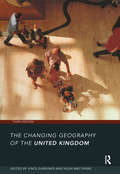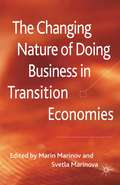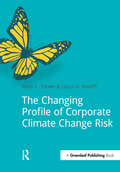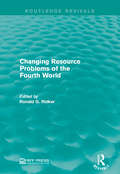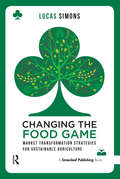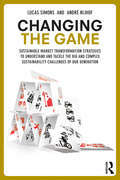- Table View
- List View
The Changing Geography of the UK 3rd Edition
by Vince Gardiner; Hugh MatthewsThis book presents a full description and interpretation of the changes that have occurred in the United Kingdom during the 1990s. It offers an understanding of the social, economic, political, and physical forces bringing about the changes in the United Kingdom.
The Changing Geography of the UK 3rd Edition
This book presents a full description and interpretation of the changes that have occurred in the United Kingdom during the 1990s. It offers an understanding of the social, economic, political, and physical forces bringing about the changes in the United Kingdom.
The Changing Global Environment
by S. Fred SingerWe know a great deal about historical climate and its variations from various geo logical studies. There are two points worth remarking on. One is that the climate changes frequently and radically, but that the degree of variation and even sense of variation depends on the time scale which we are considering. Secondly, that this is a most unusual geological period for the Planet Earth; we are living in a period of mountain building and glaciations, whereas during most of the last 250 million years (m.y.) there was little ice and little topography. A good view of climate change of the last hundred m.y. can be gained by looking at the paper of Kellogg. We are now in a period of extensive glaciations. The previous interval occurred 300 to 250 m.y. ago, when even the Sahara was glaciated. (Of course, it was at that time near the position of the South Pole; we know that 300 m.y. ago the continents had not broken apart and formed one land mass.) Apparently between 250 and 20 m.y. ago there was little ice on the Earth, even at Antarctica. Continental basins were flooded by shallow seas. This was the period when plant life and marine life proliferated and when most of our fossil fuels were laid down.
The Changing Governance of Renewable Natural Resources in Northwest Russia
by Soili Nysten-HaaralaBringing together scholars of human geography, environmental sociology, law, economics and international policy from Finland, Russia, Sweden and Germany, this book examines how local communities and enterprises adjust to transition and institutional changes in Northwest Russia. A unique and important facet of the book is that it analyzes the law and legal institutions, focusing on how those involved in law use or abuse it, in relation to unofficial institutions and the interplay of different interest groups in governing forest and fishery resources. The local view is approached empirically with data gathered through interviews, which is then compared against institutional change at national level and in the global arena. Multidisciplinary in nature, the book demonstrates innovative ways of adjusting to change, combining old and new, local and global and providing a holistic view of the Russian economy and a society in transition.
The Changing Governance of Renewable Natural Resources in Northwest Russia
by Soili Nysten-HaaralaBringing together scholars of human geography, environmental sociology, law, economics and international policy from Finland, Russia, Sweden and Germany, this book examines how local communities and enterprises adjust to transition and institutional changes in Northwest Russia. A unique and important facet of the book is that it analyzes the law and legal institutions, focusing on how those involved in law use or abuse it, in relation to unofficial institutions and the interplay of different interest groups in governing forest and fishery resources. The local view is approached empirically with data gathered through interviews, which is then compared against institutional change at national level and in the global arena. Multidisciplinary in nature, the book demonstrates innovative ways of adjusting to change, combining old and new, local and global and providing a holistic view of the Russian economy and a society in transition.
Changing Identifications and Alliances in North-east Africa: Volume I: Ethiopia and Kenya (Integration and Conflict Studies #2)
by Günther Schlee and Elizabeth E. WatsonForms of group identity play a prominent role in everyday lives and politics in northeast Africa. Case studies from Sudan, Ethiopia, Uganda, and Kenya illustrate the way that identities are formed and change over time, and how local, national, and international politics are interwoven. Specific attention is paid to the impact of modern weaponry, new technologies, religious conversion, food and land shortages, international borders, civil war, and displacement on group identities. Drawing on the expertise of anthropologists, historians and geographers, these volumes provide a significant account of a society profoundly shaped by identity politics and contribute to a better understanding of the nature of conflict and war, and forms of alliance and peacemaking, thus providing a comprehensive portrait of this troubled region.
Changing Landscapes: An Ecological Perspective
by J. Baudry F. Burel R.T.T. Forman J. F. Franklin E. R. Fuentes W. Haber W. B. Harms G. Merriam L. Miklos E. P. Odum P. Opdam P. G. Risser M. Ruzicka K. F. Schreiber J. R. Sedell F. J. Swanson M. G. Turner R. G. Woodmannsee I. S. ZonneveldLandscape Ecology is an emerging science of gaining momentum over the past few decades in the scientific as well as in the planning-management worlds. Although the field is rooted in biology and geography, the approaches to understanding the ecology of a landscape are highly divers. This hybrid vigor provides power to the field. One can no longer view a local ecosystem or land use in isolation from global areas and time frames. The surrounding landscape mosaic and the flows and movements in a landscape must be considered, especially the linkage between humans requiring resources provided by nature, the constraints on their use as well as the responding landscape.
The Changing Nature of Doing Business in Transition Economies
by Marin Marinov and Svetla MarinovaStaying at the pinnacle of the advancing business development of transition economies and the impact of changing business conditions is a challenging task for all firms wanting to do business in them. This book provides insight into the way in which businesses function with a comprehensive overview of the major aspects involved.
The Changing Nature of Geography (Routledge Library Editions: Social and Cultural Geography)
by Roger MinshullThis book is an introduction to the nature of geography. There are detailed sections on content, methods and purposes and an attempt is made to distinguish progress from those changes which are merely fashion and those which result in genuine progress. One of these, resulting partly from the adoption of quantitative techniques, is the improvement in the accuracy and the type of explanation which the geographer is now able to give. The new techniques have also helped in the bringing about of profound changes in geographical laws, the use of models and even the relevance of determinism.
The Changing Nature of Geography (Routledge Library Editions: Social and Cultural Geography)
by Roger MinshullThis book is an introduction to the nature of geography. There are detailed sections on content, methods and purposes and an attempt is made to distinguish progress from those changes which are merely fashion and those which result in genuine progress. One of these, resulting partly from the adoption of quantitative techniques, is the improvement in the accuracy and the type of explanation which the geographer is now able to give. The new techniques have also helped in the bringing about of profound changes in geographical laws, the use of models and even the relevance of determinism.
Changing our Environment, Changing Ourselves: Nature, Labour, Knowledge and Alienation
by James S. OrmrodIn this book, a celebration of the work of the sociologist Peter Dickens serves as the catalyst for exploring the relationship between human ‘internal nature’ (our health and psychological well-being) and ‘external nature’ (the environment on which we depend and which we collectively transform). Across contributions from Ted Benton, James Ormrod, Kate Soper, John Bellamy Foster and Brett Clark, Graham Sharp, James Addicott, Kathryn Dean and Peter Dickens himself, the book draws attention to alienation associated with the promotion of different knowledges in late capitalist production. But it also highlights the possibilities for generating less alienated relations with our environment in the future. As well as discussing the philosophical and theoretical issues involved, the book contains contemporary case studies of ultra-processed food, satellite farming, computerised thinking and dark tourism.
The Changing Profile of Corporate Climate Change Risk
by Mark Trexler Laura KosloffThis book will help business executives to (1) rethink their perceptions of climate risk (2) evaluate whether their company is effectively positioned, and (3) make informed and prudent business decisions about climate change risk in an environment rife with policy uncertainty.Business risk associated with climate change is commonly assumed to be primarily policy driven. Many companies internalize the current stalemate over global climate policy into a perception that climate risk is no longer a critical issue. Business climate risks, however, include: Operational and Supply Chain (Physical) Risk, Brand Risk, Market-driven Structural Risk, Liability Risk.As national and global policy to materially reduce climate change is delayed, it is business-prudent to assume that the level of climate risk is increasing. Even if policy risk might seem lower today than a few years ago, political will can change quickly. Should physical impacts of climate change manifest in dramatic ways, for example, draconian climate policy is likely to follow quickly. These conditions create a complex and shifting business risk environment, and most companies either overlook or substantially underestimate key climate risks. How many companies, for example, are positioned for material climate change outcomes, whether physical or regulatory? Companies with little climate change exposure may not face much downside risk from taking a wait-and-see approach. For those with greater exposure, being "too late" to respond will mean costs and competitive impacts that could have been avoided. Being "too early," however, can mean being penalized later for actions that reduce a company’s emissions today, or competitive disadvantage from getting too far out in front of competitors.
The Changing Profile of Corporate Climate Change Risk
by Mark Trexler Laura KosloffThis book will help business executives to (1) rethink their perceptions of climate risk (2) evaluate whether their company is effectively positioned, and (3) make informed and prudent business decisions about climate change risk in an environment rife with policy uncertainty.Business risk associated with climate change is commonly assumed to be primarily policy driven. Many companies internalize the current stalemate over global climate policy into a perception that climate risk is no longer a critical issue. Business climate risks, however, include: Operational and Supply Chain (Physical) Risk, Brand Risk, Market-driven Structural Risk, Liability Risk.As national and global policy to materially reduce climate change is delayed, it is business-prudent to assume that the level of climate risk is increasing. Even if policy risk might seem lower today than a few years ago, political will can change quickly. Should physical impacts of climate change manifest in dramatic ways, for example, draconian climate policy is likely to follow quickly. These conditions create a complex and shifting business risk environment, and most companies either overlook or substantially underestimate key climate risks. How many companies, for example, are positioned for material climate change outcomes, whether physical or regulatory? Companies with little climate change exposure may not face much downside risk from taking a wait-and-see approach. For those with greater exposure, being "too late" to respond will mean costs and competitive impacts that could have been avoided. Being "too early," however, can mean being penalized later for actions that reduce a company’s emissions today, or competitive disadvantage from getting too far out in front of competitors.
Changing Representations of Nature and the City: The 1960s-1970s and their Legacies (Routledge Advances in Art and Visual Studies)
by Gabriel N. Gee Alison VogelaarThe turn of the 1960s-70s, characterized by the rapid acceleration of globalization, prompted a radical transformation in the perception of urban and natural environments. The urban revolution and related prospect of the total urbanisation of the planet, in concert with rapid population growth and resource exploitation, instigated a surge in environmental awareness and activism. One implication of this moment is a growing recognition of the integration and interconnection of natural and urban entities. The present collection is an interdisciplinary inquiry into the changing modes of representation of nature in the city beginning from the turn of the 1960s/70s. Bringing together a number of different disciplinary approaches, including architectural studies and aesthetics, heritage studies and economics, environmental science and communication, the collection reflects upon the changing perception of socio-natures in the context of increasing urban expansion and global interconnectedness as they are/were manifest in specific representations. Using cases studies from around the globe, the collection offers a historical and theoretical understanding of a paradigmatic shift whose material and symbolic legacies are still accompanying us in the early 21st century.
Changing Representations of Nature and the City: The 1960s-1970s and their Legacies (Routledge Advances in Art and Visual Studies)
by Gabriel N. Gee Alison VogelaarThe turn of the 1960s-70s, characterized by the rapid acceleration of globalization, prompted a radical transformation in the perception of urban and natural environments. The urban revolution and related prospect of the total urbanisation of the planet, in concert with rapid population growth and resource exploitation, instigated a surge in environmental awareness and activism. One implication of this moment is a growing recognition of the integration and interconnection of natural and urban entities. The present collection is an interdisciplinary inquiry into the changing modes of representation of nature in the city beginning from the turn of the 1960s/70s. Bringing together a number of different disciplinary approaches, including architectural studies and aesthetics, heritage studies and economics, environmental science and communication, the collection reflects upon the changing perception of socio-natures in the context of increasing urban expansion and global interconnectedness as they are/were manifest in specific representations. Using cases studies from around the globe, the collection offers a historical and theoretical understanding of a paradigmatic shift whose material and symbolic legacies are still accompanying us in the early 21st century.
Changing Resource Problems of the Fourth World (Routledge Revivals)
by Ronald G. RidkerClimbing food, fertiliser and mineral prices as well as the Arab oil embargo in the seventies had severe economic consequences in developing countries. Originally published in 1976, this study explores the effects of these developments in the fourth world and how they can adjust to an international economy with a particular focus on resource availability in terms of energy and agriculture. This title will be of interest to students of Environmental Studies.
Changing Resource Problems of the Fourth World (Routledge Revivals)
by Ronald G. RidkerClimbing food, fertiliser and mineral prices as well as the Arab oil embargo in the seventies had severe economic consequences in developing countries. Originally published in 1976, this study explores the effects of these developments in the fourth world and how they can adjust to an international economy with a particular focus on resource availability in terms of energy and agriculture. This title will be of interest to students of Environmental Studies.
Changing Roles in Natural Forest Management: Stakeholders' Role in the Eastern Arc Mountains, Tanzania
by Kerry A WoodcockThis title was first published in 2002. The paramount question facing natural resource management is how to develop sustainable management approaches. Illustrated by an in-depth study of the Eastern Arc Mountains of Tanzania, this volume examines the role of community in the management of natural resources along with stakeholders' rights, responsibilities and relationships to the forest. The author: reviews the significance of natural forest in the Eastern Arc; identifies changing forest management approaches in Tanzania; identifies stakeholders in natural forest management and whether they are primary or secondary stakeholders; examines historical imbalances in stakeholders' roles and relations between stakeholders; and draws conclusions on the effect of imbalances in stakeholders' roles on the development of sustainable forest management practices in the Eastern Arc.
Changing Roles in Natural Forest Management: Stakeholders' Role in the Eastern Arc Mountains, Tanzania
by Kerry A WoodcockThis title was first published in 2002. The paramount question facing natural resource management is how to develop sustainable management approaches. Illustrated by an in-depth study of the Eastern Arc Mountains of Tanzania, this volume examines the role of community in the management of natural resources along with stakeholders' rights, responsibilities and relationships to the forest. The author: reviews the significance of natural forest in the Eastern Arc; identifies changing forest management approaches in Tanzania; identifies stakeholders in natural forest management and whether they are primary or secondary stakeholders; examines historical imbalances in stakeholders' roles and relations between stakeholders; and draws conclusions on the effect of imbalances in stakeholders' roles on the development of sustainable forest management practices in the Eastern Arc.
The Changing Space Economy of City-Regions: The Gauteng City-Region, South Africa (GeoJournal Library)
by Koech CheruiyotThis book addresses the South African Space Economy and its stark disparities and dualisms through an assessment of the Gauteng City-Region – the largest economic agglomeration in the country and on a continent bedevilled by a myriad of development challenges. The book’s focus on understanding the overall character of Gauteng City-Region’s Space Economy – through data mining/analysis and mapping – comprehensively supplements the Space Economy literature on the region. It covers the disparities exacerbated by an overlay of apartheid planning ideology and top-down regional development based on selective encouragement of manufacturing investments in growth points or poles and how implementation of past policies intended to cure these disparities have yielded mixed results. This book further offers the Gauteng City-Region as a microcosm of the national economy in the form of evident significant placed-based variations in the intensity and character of economic structure that on the one hand enjoys massive agglomeration economies, while on the other, has high levels of poverty and large numbers of people living below the Minimum Living Level. This book should appeal to urban studies specialists, economists and development studies researchers in the Global South.
Changing Spatial Elements in Chinese Socio-economic Five-year Plan: From Project Layout To Spatial Planning (Springer Geography)
by Lei WangAs a legacy of the socialist state with central planning, Five-Year Planning (FYP) is very important in regulating socio-economic and spatial development even in post-reform China. This book tries to fill the research gap between examining the role of FYP and how spatial elements in the FYP mechanism have operated and transformed in spatial regulatory practices in transitional China. By building a conceptual framework and studying two empirical cases at different spatial scales, with the help of both qualitative and quantitative methods, it helps to understand various stakeholders, institutions and planning administrations, mechanisms of articulating spatial planning into the FYP system and the effectiveness of spatial planning in solving place-specific governance issues in urban and regional China.
The Changing Status of Arable Habitats in Europe: A Nature Conservation Review
by Clive Hurford Phil Wilson Jonathan StorkeyThis edited volume documents the current nature conservation status of arable habitats in Europe. Arable farming systems have evolved in the European landscape over more than ten thousand years and now occupy nearly 30% of the European land area. They support species that have life cycles closely synchronised with traditional cereal growing, many of which have experienced massive declines throughout Europe. For example, in Britain, of the 100 plant species exhibiting the greatest declines in the latter half of the 20th century, 47 were typical of arable land. Despite this the habitat and many of the species associated with it remains unprotected across much of Europe. The 22 chapters cover a range of topics, including: · Regional accounts describing the impact of changing agricultural practices on the arable flora;· The results of research and surveillance projects on the soil organisms, bryophyte flora, invertebrate fauna and pollinators of arable habitats;· The potential for designing multifunctional and resilient agricultural landscapes; The use of ex situ conservation to aid the reintroduction of rare arable plants;· Case studies illustrating how changing agricultural practices have impacted on bird populations in Europe; · The roles of remote sensing in monitoring agricultural systems; · How agri-environment schemes can help restore the biodiversity in arable habitats; and · A look forward at ways to help ensure the future security of the species associated with arable habitats. It is clear that the biodiversity of arable land throughout Europe has undergone major changes, particularly during the second half of the 20th century, and that these changes are continuing into the 21st century. We need to develop a deeper appreciation of farmland wildlife and its integration into farming systems to ensure its future security in a world where value is increasingly expressed in terms of material profit. This book is particularly relevant to practitioners, policy-makers and managers working in the fields of nature conservation, agri-environment schemes and land management, and to researchers working in the fields of conservation biology, terrestrial ecology, nature conservation, applied ecology, biodiversity, agriculture, agricultural ethics and environmental studies.
Changing the Food Game: Market Transformation Strategies for Sustainable Agriculture
by Lucas SimonsBy 2050, the world’s population is estimated to grow to 10 billion. To feed everyone, we will have to double our food production, to produce more food in the next 40 years than in the whole of the last 6,000. Changing the Food Game shows how our unsustainable food production system cannot support this growth. In this prescient book, Lucas Simons argues that the biggest challenge for our generation can only be solved by effective market transformation to achieve sustainable agriculture and food production. Lucas Simons explains clearly how we have created a production and trading system that is inherently unsustainable. But he also demonstrates that we have reason to be hopeful – from a sustainability race in the cocoa industry to examples of market transformation taking place in palm oil, timber, and sugarcane production. He also poses the question: where next? Provocative and eye-opening, Changing the Food Game uncovers the real story of how our food makes it on to our plates and presents a game-changing solution to revolutionize the industry.
Changing the Food Game: Market Transformation Strategies for Sustainable Agriculture
by Lucas SimonsBy 2050, the world’s population is estimated to grow to 10 billion. To feed everyone, we will have to double our food production, to produce more food in the next 40 years than in the whole of the last 6,000. Changing the Food Game shows how our unsustainable food production system cannot support this growth. In this prescient book, Lucas Simons argues that the biggest challenge for our generation can only be solved by effective market transformation to achieve sustainable agriculture and food production. Lucas Simons explains clearly how we have created a production and trading system that is inherently unsustainable. But he also demonstrates that we have reason to be hopeful – from a sustainability race in the cocoa industry to examples of market transformation taking place in palm oil, timber, and sugarcane production. He also poses the question: where next? Provocative and eye-opening, Changing the Food Game uncovers the real story of how our food makes it on to our plates and presents a game-changing solution to revolutionize the industry.
Changing the Game: Sustainable Market Transformation Strategies to Understand and Tackle the Big and Complex Sustainability Challenges of Our Generation
by Lucas Simons Andre NijhofWe are at the beginning of the sustainability era. The biggest challenge of our generation is to reach the Sustainable Development Goals. For this we must be willing to understand and change the root causes that create these challenges in the first place. The system itself needs to change. But how to do that? This ground-breaking book Changing the Game reveals the missing insights and strategies to actually achieve system change. The authors Lucas Simons and André Nijhof bring decades of real life and academic experience, and state that most of the sustainability challenges are actually caused by the same system failures, every time. Therefore, the way to accelerate and manage system change is also similar every time – if you know where to look and how to act. The theory of sustainable market transformation and system change is described in a compelling and easy to understand eight-step approach applied to eight different sectors. The authors, together with respected sector experts, describe the drivers, triggers and dominant thinking in each of these sectors as well as the strategies needed to move towards higher levels of sustainability. This book is highly accessible and engaging, and is perfect for use by professionals, leaders and students for understanding how to move markets to a more sustainable future.
